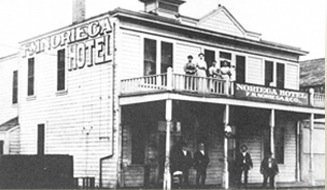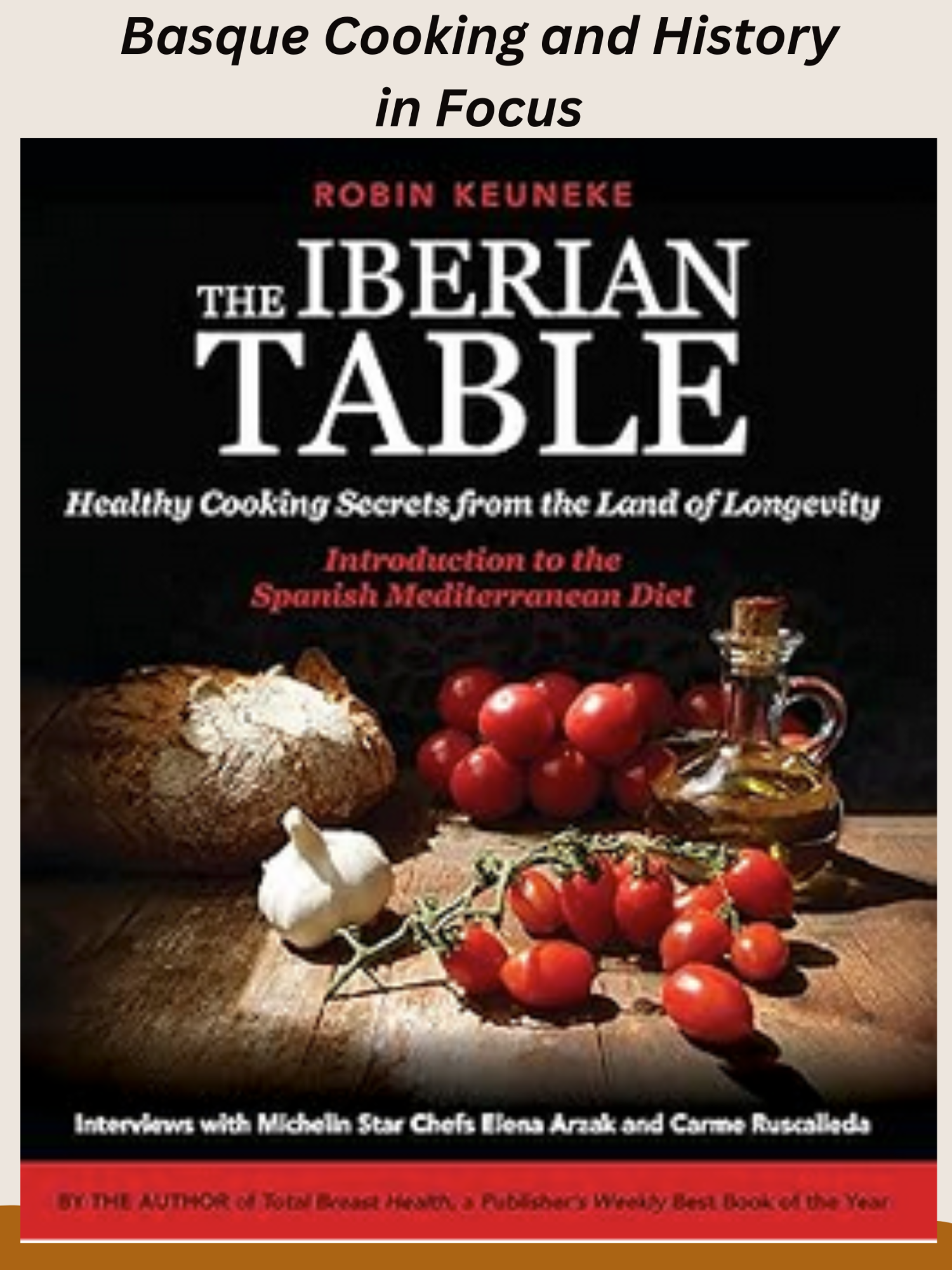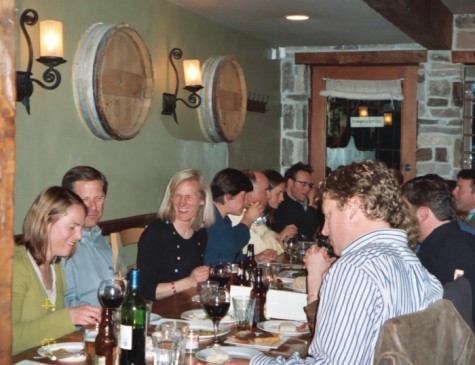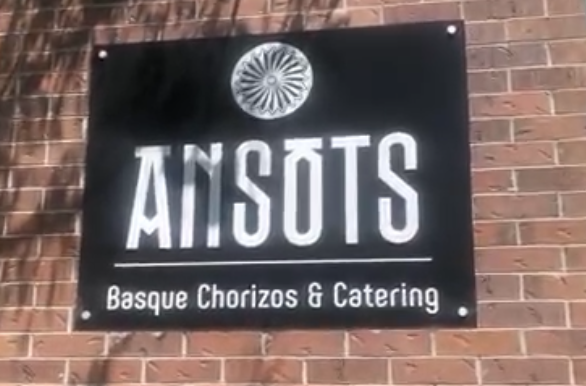Kern County’s Basque History Highlighted in New Book

The Noriega Hotel in early Bakersfield.
January 26, 2013
The history of the many Basques in Kern County has been painstakingly recreated by authors and researchers Steve Bass and George Ansolabehere, who recently published their work in a book, “The Basques of Kern County.”
The book is full of the history of longtime local families such as the Errecas, the Bidarts, the Maiteas, the Ansolabeheres, the Otharts.
“We uncovered a lot of things that were very interesting,” said Bass, a retired history teacher who previously spent a considerable amount of time researching early Basque explorers to the New World. Ansolabehere, a retired civil engineer, had previously researched the large Ansolabehere family tree and was very familiar with Bakersfield’s Basque families.
Read about what the Bakersfield Californian had to say about their book.
Among the intriguing facts they discovered was the story of Gracian Etchechury who walked to Kern County from Argentina, the fact that early sheep rancher Jean Bidart died in the Spanish flu epidemic of 1918, and that the family members running the Pyrenees Bakery are relatives of the first Basque woman in Kern County, Marianne Laxague.
They researched all the early Basque hotels and uncovered that the Hotel Des Alpes had been located right next to the latest Pyrenees Bakery building, but no one knew, said Bass, because it was converted to a commercial building.

The largest working ranch in California — the Tejon Ranch just south of Bakersfield — first belonged to a Basque, Jose Antonio Aguirre, who was awarded the ranch in 1843 as one of the early Mexican land grants.
Three Inda sisters were mentioned among the earliest immigrants to Bakersfield, but Bass and Ansolabehere discovered a fourth sister, Mary. All of them married prominent early Basque pioneers.
RELATED CHRONOLOGIES:
Basques in the Americas 1492-1592
Basques in the Americas 1592-1692
Basques in the Americas 1692-1792
Basques in the Americas 1792-1893
Also be sure to see the comments at the bottom of the page.
The largest family may be the Ansolabeheres. Their first ancestor to Bakersfield was Jean, who arrived in 1881. He married Marie Eyherabide and they had nine children. Other relatives from the same family joined them. At one point, Bass noted, five Michel Ansolabeheres were living in the Bakersfield area. Teachers were confused by the large family to the extent that they renamed two cousins who were both named Jean Ansolabehere, “John Five” and “JohnSix,” based on the grade they were in. “That’s all they were ever called, because they couldn’t tell them apart,” noted Bass.
Mary Grace Paquette’s book, “Basques to Bakersfield,” published by the Kern County Historical Society in 1982, was the pioneering work on the topic, and the two men used much of the information as the basis of their book.
“She did a fantastic job,” said Bass, noting that they were able to verify almost everything she wrote with current family members. Some name misspellings were corrected. Bass noted that she mostly collected information through interviews, which may have led her to misspell a few of the complex Basque names. The two men visited Union Cemetery, Bakersfield’s oldest cemetery, and looked for gravestones to confirm spellings.
The old Basque neighborhood was in what was then known as East Bakersfield, next to the train depot. They were able to pinpoint former restaurants, hotels and grocery stores. They interviewed at least 100 people for the book, a couple of whom have died since then. The authors note in their book that they feared that much of the history of the local Basque families would disappear if they didn’t record it.
Bass notes that he first got the idea for the book when Professor Steve Gamboa of Cal State Bakersfield asked him to speak on the early Kern County Basques in 2009. Since then, Gamboa, a philosophy professor, always passes requests for presentations to Bass, including one on Jan. 12 for the Kern County Historical Society.
Bass, whose wife is Basque, first became interested in Basque history many years ago when he took a class on Mexico and noted that a lot of the historical names mentioned were Basque, yet they were called Spaniards.
Much of the book is made up of vignettes of local Basques. which are included word-for-word from interviews. Bass said almost all the men started out as sheepherders, although there were a couple of chefs and another couple of cowboys. Almost all the Spanish Basques immigrated from the Baztan Valley in Nafarroa, while the French Basques came mostly from the towns of Baigorri, Urepel, Aldudes and Banka.
The authors also used a lot of data collected by Basque researcher Koldo San Sebastian of Reno. Bass notes that the research and writing took three years to research.
The book was self-published by the Kern County Basque Club. A short spiral-bound version. 70-pages-long, of the book was published in time for the 2010 Kern County Basque Festival. Bass notes that the 500 copies “were immediately snatched up.”
Only one significant problem surfaced while publishing the 300-page book. It has no index. Bass notes that creating the index, which had to be done after the pages were printed, would have fallen to him, and with the hundreds of names, many of them duplicate and triplicate names, “it would have been a mind bender.” The missing index will hinder researchers, but is not likely to bother those reading for pleasure.
For more information, please email Bass at [email protected]. If you’d like to order by mail, send your name and address and $25 per book to cover tax and shipping to Kern History Book, c/o 12012 Tulane Park Place, Bakersfield, CA 93311. Checks must be made out to the Kern County Basque Club. (Purchase info updated May 2021)


 Donate
Donate



David Daley • Jul 29, 2020 at 2:20 pm
Hello. I am talking with my Dad about the Basque restaurant that used to be on Union Avenue, that I believe later was converted into the Casino. What was the name of that restaurant?
Thank you so much.
Nancy Zubiri • Aug 2, 2020 at 10:39 pm
I think you are talking about the Chateau Basque. It happened to be run by my cousins, the Etchevestes. It was a big large building with room for lots of banquets and they often had live music on weekends. Is that the one?
Nancy Zubiri • Jul 1, 2022 at 4:05 pm
That was the Chateau Basque, a wonderful restaurant for many years.
Yolanda Flores • Dec 5, 2016 at 11:46 am
This history is so fascinating. I think I knew Mr Loustaunua. I was born and raised in the 800 block of Eureka Street. My parents bought their first house from Mr. Noriega and Judge Noriega married them too. My grandmother’s maiden name was Marichalar, and her grandparents were Zuloaga. Her grand uncle was Felix Zuluaga, a generaL under Santana and President of Mexico. I would love to know more. Oh, my grandfather Abel was a cook at one of the Basque restaurants. Always in search.
Lori Loustaunau • Dec 30, 2013 at 1:26 pm
Thank you for the validating information, as I have been researching the Culture in California history as it connects to the family history if the Loustaunaus’ as well.
Specifically, Mr. Loustaunau, I would welcome a response from you in that I believe our information may be worthy of exchange.
Ms. L Loustaunau
Frank Lostaunau • Feb 2, 2013 at 5:26 pm
The Basque people in Bakersfield are Catholic. I strongly suggest that you pay close attention to how Catholic clergy, priests/nuns, relate to your children.
I am a member of the Survivors Network of those Abused by Priests (SNAP). Given what we know, there is absolutely no reason to believe that your children are safe in the presence of any Catholic clergy. I strongly recommend that none of your children be allowed to be alone with Catholic priests/nun.
May you and your children always remain safe.
Quico Antonio Lostaunau
Frank Lostaunau • Feb 2, 2013 at 3:47 pm
As a kid I trucked around town with my father and ocassionally we encountered a few depressed shepherds. I also met up with a few Basque males when I worked for Community Mental Health Services in San Francisco. Most of the Basque males were depressed and a few presented with psychosis. I was not familiar with the literature re: mental illness in Basque immigrants. Most of the men that I encountered in public health clinics initially would not speak in English, Spanish, or French. When meds kicked in, they responded in various languages. A few returned to the Basque homeland and others were discharged to either family/friends or to the street. Having been raised in Bakersfield, I found it heartbreaking to encounter shepherds with mental health problems. At the time, there was absolutely no professional training to manage this patient population.
Frank Lostaunau • Feb 2, 2013 at 11:35 am
The issues of Race, Class, and Undesirable Differentness rarely get talked about when stories appear on this blog.
Frank Lostaunau • Jan 30, 2013 at 8:15 am
Wenceslao Ricardo Islas Loustaunau:
http://www.findagrave.com/cgi-bin/fg.cgi?page=gr&GRid=29650791
Frank Lostaunau • Jan 29, 2013 at 11:21 pm
RE: Don Garate – Prior to his death, I was in contact via email with the late Don Garate. He was such a sweet and gentle soul. I sure miss him. He didn’t know me but responded to my questions as if were were old pals. I was so deeply touched.
He responded immediately after I made contact. He knew about my family history and informed me that I was related to Wenceslao Ricardo Islas Loustaunau. He had so much information and knew the entire Loustaunau family history. He was very clear that through the Islas line, I was indeed a decendant of Juan Bautista de Anza. I was STUNNED! I have never known anybody who knew so much about my family history. Don Garate was a very very special man and I will never forget him. I am so grateful.
Frank Lostaunau • Jan 29, 2013 at 11:04 pm
What an interesting article! I was born in Bakersfield in 1942 and my family lived about 6 blocks from several Basque restaurants close to the train station in East Bakersfield.
My father, Enrique, seemed to know everybody in town. I remember visiting Judge Noriega and sitting on his lap as a kid. He was very kind to our family and encouraged dad to work as a translator in his court. He worked with the Mexican migrant workers who got busted and jailed. It was very painful seeing the hundreds of “wetbacks” placed in corrals in unbearable heat during the summer. It was not unusual for my father to invite the “wetbacks” to dinner in our home. Judge Noriega married my parents. Even though my sister, brother, and I attended Nuestra Senora de Guadalupe Catholic church, my parents almost never attended mass?
Nobody can live in Bakersfield without enjoying a dinner at one of the various Basque restaurants. I loved the cold tongue and vegetable soups best. Not to mention the lamb! My father’s picture was in the hallway between the bar and the dining room at the Wool Growers Restaurant
which was connected to the Spanish Kitchen.
Mother would often send me to the Pyrenees Bakery to pick up a few loaves of bread. She would warm it up in the oven and I would always dip it in butter! It was such a joy to gobble it down. Incidentally, I do remember the Hotel des Alps.
I have more memories the more I think and respond to this story. Maybe another time. Thank you for sending me this article Nancy.